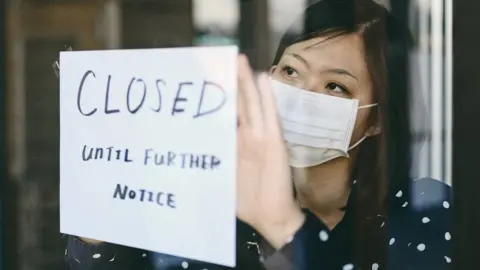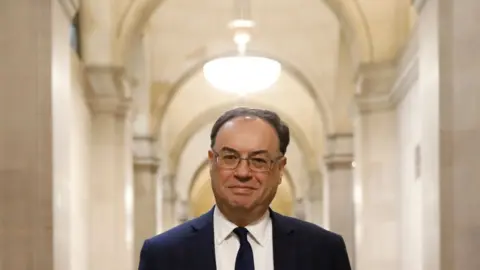Bailey: Coronavirus bounce back 'could be fast'

 Getty Images
Getty ImagesYou have only to leave the imposing front doors of the Bank of England to see the empty square outside the famous shuttered Royal Exchange, apart from three construction workers and one homeless man, in the heart of the Square Mile.
The Bank of England itself has minimal staff, but they have applied themselves to try to work out what is happening in the economy.
They are not sufficiently confident that the numbers they have run, the charts that they have published, constitute what they would call a "forecast".
But they do give the clearest indication that we are in recession, after the sharpest, fastest economic contraction in the three-century history of the Bank looking at these things.
Faster than the financial crisis, and the Great Depression, and the earlier 1920s depression just before, the only things which come close.
The fall began in the first quarter, the official numbers will confirm next week, but really accelerated in the current quarter. So a recession starting like none before, and many millions of British workers won't need to look at a chart to know that.
"It is unprecedented in the recent history of this institution," Andrew Bailey told me.
"What it really means is that obviously the very sharp sort of downturn, a product of the situation we've been in since March, and the restrictions that are in place, affect economic activity very severely,"
A recession? "Yes," he replied.
 Getty Images
Getty ImagesBut the other call in this report is that it could end almost as rapidly, with huge rises as the economy is put back to work going into next year.
That is far more uncertain, but hinges on a gradual lifting of the lockdown, starting next month, and no second wave of the pandemic.
But that is as much a product of what doctors and politicians do as economists.
Mr Bailey told me that its scenario was built on the Bank consulting with epidemiologists and with the government on its plans for lockdown and track-and-trace.
The governor said the recovery would be "nowhere near as fast" as the fall we are currently experiencing.
This is based on an assumption the economy will only be gradually released from lockdown. Its numbers contain some considerable expectations that consumer and worker behaviour will change, and continue for some time, with forms of voluntary social distancing.
On the other hand, Mr Bailey expects the recovery to be "much faster" than seen with the financial crisis a decade ago, as long as there are "the right measures in place from the public health side - that is, no second wave - and the fact that it's supposed by the very sensible things that the government has done in terms of the measures that the chancellor has put in place, that economic activity can recover much more quickly".
That is the hope. It is a hope given confidence from the success of the furlough scheme.
I asked the governor if the government should adopt a more flexible version of the scheme based on hours worked.
 Getty Images
Getty ImagesHe said the chancellor "will focus on that, rightly so" and added that he expected announcements alongside decisions around the lockdown.
He said the furlough scheme was "really working" and that it "really enables people to come back into the economy more quickly" and therefore gives a "much quicker recovery than you've seen in the past".
He also, after last month's criticism of the rate of lending to business, said new small business loan schemes were working and he was "very optimistic" about that.
So "bouncing back" requires a view on public health and government reactions here and around the world, well beyond the fortified walls of the Bank.
The scenario, as bad as it is, is far from a worst case.
